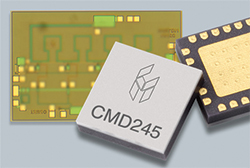
A microwave system’s phase noise impacts everything from target acquisition in radars to spectral integrity in communications systems, with direct down-conversion receivers and radar transceivers especially sensitive to phase noise. A new line of low phase noise amplifier (LPNA) MMICs from Custom MMIC was developed to address this problem.
The direct down-conversion receiver is popular in microwave communications systems due to its circuit simplicity. The receiver comprises a single mixer driven by a local oscillator (LO), which converts the input RF signal to a very low baseband frequency. The baseband signal is applied to an analog-to-digital converter for digital processing. A common term for this architecture is “RF in, bits out.” One problem with direct down-conversion is the input RF frequency being very close to the LO frequency, making the down-conversion susceptible to phase noise, especially if the RF signal strength is low.
In radar systems, the problem is similar. Doppler radar operates by transmitting a pulse at one frequency, then measuring the frequency shift of the return pulse, which is proportional to the velocity of the object being imaged. Objects moving slowly will generate a return pulse close in frequency to the transmitted pulse, and if the cross section of the object is very small—such as from a UAV—the power level of the received signal will be very low. As the return pulse is converted to baseband to recover the velocity information, phase noise can obscure this data.
The dilemma faced by direct conversion receivers and radar systems is seen in Figure 1, which shows if the power of the RF signal being converted falls below the phase noise spectrum of the LO signal, no baseband information can be recovered, since the signal is obscured by the noise. Reducing the phase noise will increase receiver sensitivity.
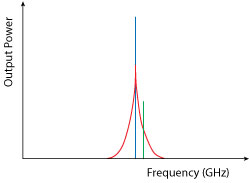
Figure 1 Ideal LO signal (blue), LO signal with phase noise (red) and a close-in RF signal to be converted to baseband.
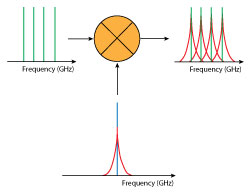
Figure 2 Phase noise issues in OFDM systems: ideal LO signal (blue), LO signal with phase noise (red) and RF signal (green).
The impact of phase noise when down-converting a multi-carrier orthogonal frequency-division multiplexed (OFDM) signal is shown in Figure 2. If the phase noise of the LO is too high, the noise will be converted into adjacent channels of the baseband data, ruining the integrity of the
information.
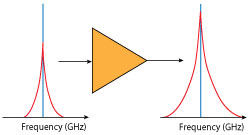
Figure 3 Phase noise degradation due to an amplifier: the skirts of the input signal on the left are increased after passing through the amplifier, yielding the output spectrum on the right.
WHERE TO START?
One obvious place to limit phase noise is the oscillator, i.e., spending considerable time and money to design or procure a low noise oscillator. However, most oscillators do not generate sufficient output power to drive the LO input of a mixer and need a post amplifier. If an oscillator output of +5 dBm needs to be amplified to +15 to +17 dBm to drive the LO port of the mixer, will the amplifier affect the phase noise of the LO signal? Ideally, the answer is “no,” as the amplifier simply raises the desired LO signal and its skirts by the same level.
However, the reality is microwave amplifiers add noise, generated by a phenomenon called 1/f or flicker noise, noise power added to the input signal with a spectrum that falls off proportionally to the inverse of the offset frequency. If this noise is greater than the phase noise of the input signal, then amplifier noise will dominate the output noise spectrum—and the low phase noise of the oscillator will be replaced by the higher phase noise of the amplifier—defeating the purpose of a low phase noise oscillator (see Figure 3).
Understanding this, the amplifier becomes another component to address in the chain. Why has this not been addressed before? The answer lies in device physics: 1/f noise is caused by random and thermal charge movement in the channel of an active device. FETs fabricated using a GaAs PHEMT process typically have a higher frequency 1/f corner because of high electron mobility. On the other hand, GaAs bipolar devices (e.g., HBT) tend to have lower electron mobilities, which results in a much lower 1/f noise, and they have considerably better phase noise than their FET counterparts (see Figure 4). Therefore, one solution for lowering the additive phase noise is to use a GaAs HBT process.
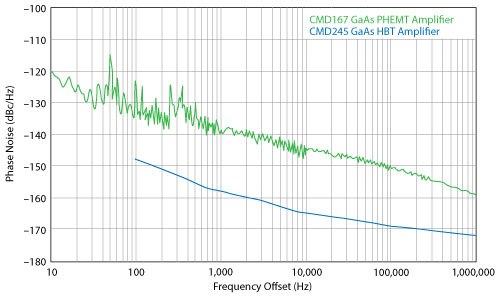
Figure 4 The phase noise of a GaAs PHEMT amplifier (CMD167) is typically greater than that of a GaAs HBT amplifier (CMD245)
After exploring this option for some time, Custom MMIC recently released a family of off-the-shelf, LPNA MMICs fabricated with a GaAs HBT process. Models offering wideband coverage are available from DC to 40 GHz and are matched to 50 Ω. The five products in the family achieve phase noise performance as low as ‐165 dBc/Hz at 10 kHz offset. They also feature low noise figures down to 3 dB, high linearity with OIP3 as high as 29 dBm and 18 dB gain to 18 GHz, 17 dB to 22 GHz and 13 dB to 40 GHz. The MMIC family includes three die and two packaged MMICs in a 4 mm x 4 mm QFN. These amplifiers are being used in a variety of LO and high sensitivity receiver circuits for military and instrumentation applications. An additional benefit of these designs is self-biasing; they require only a single positive power supply of 3 to 5 V, reducing the need for the extensive biasing circuitry required by devices using a negative supply.
These amplifiers are being used in a variety of LO and high sensitivity receiver circuits for military and instrumentation applications.
OTHER WAYS TO ADDRESS PHASE NOISE
Other components besides oscillators and amplifiers contribute to phase noise, including frequency multipliers. Some microwave systems use a lower frequency oscillator multiplied to produce a higher frequency. One common approach to multiplication is using a harmonically terminated amplifier to generate the required output frequency. Unfortunately, this adds the amplifier’s phase noise to the multiplied signal, which degrades the phase noise of the original oscillator. A second approach is passive multiplication, which adds minimal phase noise to the multiplied signal. Custom MMIC has also developed a family of passive HBT frequency multipliers which do not add to the phase noise of the input signal.
Extensive datasheets, S-parameters and evaluation boards for all Custom MMIC’s products are available on the website.
Custom MMIC
Chelmsford, Mass.
www.CustomMMIC.com
